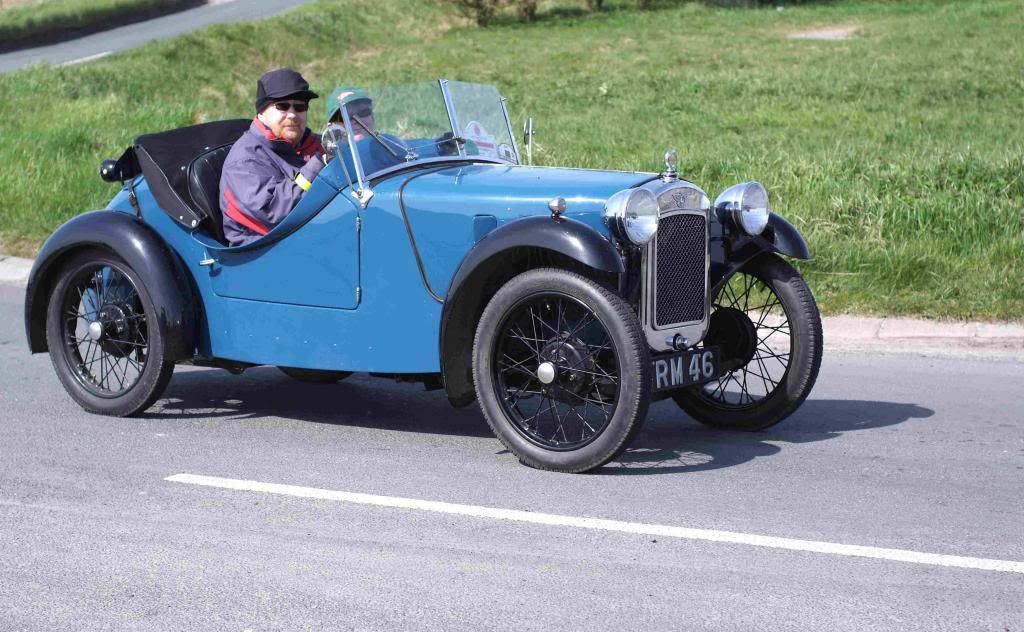
Welcome to the Austin Seven Friends web site and forum
As announced earlier, this forum with it's respective web address will go offline within the next days!
Please follow the link to our new forum
http://www.austinsevenfriends.co.uk/forum
and make sure, you readjust your link button to the new address!
if anyone is interested
http://www.ebay.co.uk/itm/Austin-Seven-7-Ulster-Nippy-Pressure-Fed-Crank-/271878183881?pt=LH_DefaultDomain_3&hash=item3f4d33dbc9
Certainly interesting. All there except a crack test certificate. Has the rear journal been built up with copper? Certainly less damaging than the usual weld or braze. A thin sleeve and metric bearing seems the obvious cure. The conrods look promising. Is it not usual to provide a slight relief at the part line? In early editions Ricardo did not approve of big ends waisted at the join as these tend to close under tension, but the forces in a small Seven would be modest.
The explanation for the circumferential ducts seems obvious but when you consider that any pressure lost against centrifugal force is recovered after the axis is crossed, not so obvious. Presumably flow and loss causes a large drop to no 3.
Bob Culver
Location: Auckland
http://www.ebay.co.uk/itm/Austin-Seven-7-Ulster-Nippy-Pressure-Fed-Crank-/271878183881?pt=LH_DefaultDomain_3&hash=item3f4d33dbc9
It’s stamped 192511
Quick look in the A7CA register.
It’s from AOE 69, C193975, mid 1934 EK 75 (Speedy)
You are right Bob rear journal has been copper plated and "popped" up the little end eyes too I think.
The crank is a lucky dip,possibly expensive lucky dip without a genuine crack test certificate.
The late Steve Cotterill used to say around 1 in 4 cranks he tested were good.
The crank is a lucky dip,possibly expensive lucky dip without a genuine crack test certificate.
The late Steve Cotterill used to say around 1 in 4 cranks he tested were good.
What is the preferred crack testing method for Austin cranks?
There must be a lot of those cranks sitting on shelves with near bullet proof Phoenix cranks doing stirling work in their place. A great historic piece but thats about all.
http://www.ebay.co.uk/itm/Austin-Seven-7-Ulster-Nippy-Pressure-Fed-Crank-/271878183881?pt=LH_DefaultDomain_3&hash=item3f4d33dbc9
It’s stamped 192511
Quick look in the A7CA register.
It’s from AOE 69, C193975, mid 1934 EK 75 (Speedy)
Valuable to the owner of that car.
Sculpture to the rest of us!
Charles
Late pressure fed 3 bearing sports crank....
http://www.ebay.co.uk/itm/231563616878?_trksid=p2060353.m1438.l2649&ssPageName=STRK%3AMEBIDX%3AIT
I got this crank with a load of spares when buying a couple of race cars from a recently retired a7 racer friend. Ironically, the engine had one of the aforementioned bullet proof phoenix cranks in, which it turns out, wasn't so bullet proof.
Does anyone know the owner of AOE 69, is the car still in existence?
The crank would look great in the china cabinet.
I am sceptical of the spray dye home kits...although the one I saw used ineffectively may have exceeded its shelf life. I think most commercial magnetic methods now use ultraviolet light, but if the suspect places are shiny the old style black magnetic fluids adequate. Nowadays most major engine rebuilders seem to do crack testing. The traditional method was to soak in dirty kerosene (UK paraffin?) dry, wallop with a hammer, then dust with talc. laying in the hot sun often causes kero to exude.
Main suspect areas on normal use cars are inside radius of fillets, starting at no 4 rear. Any crank showing signs of brazing or welding or square machining often cracked at rear journal. My success rate finding sound cranks is about 0 out of 10! The one in the car was OK when tested... just 100 million revolutions ago!.
If the crank does not ring it is likely very seriously cracked.
Unless known to be seriously defective, it is annoying to see old parts rust damaged. Adds greatly to recondition cost and often cannot restore fully. Brushing parts with engine oil old or new is not satisfactory as it dries. Grease is a better preservative. Parts which seem scrap to one can often be utilised with little work by others but rust can ruin completely, and once established is hard to stop. A great deal of moisture falls out of the air.
Those who pull things to pieces please grease and keep in covered metal or plastic containers. (I realise the part is recently acquired)
The notion that Phoenix cranks are immortal is somewhat fanciful. Nitriding, presumably the key virtue of the Phoenix, can improve the fatigue stress limit perhaps 30%. A small increase has a colossal effect on life at original stress, so 30% would keep a stock car running beyond eternity. But raising cr to 7:1 increases peak firing stresses much the same percentage, and then there is often the modern rpm to contend with.
Bob Culver
Location: Auckland
75 Sports AOE 69 was last reported to be owned by a gentleman in Norfolk. First registered 21 June 1934. I last saw it at Beaulieu some 20 years ago.
As Speedy Registrar the details I have are:
75 SPORTS Shortened tail (50’s?) more like a special but still recognisable. Fitted with a Grasshopper type fold-flat screen. Photo in Light Car 7/12/34 at Mid Surrey A.C. 1934 Experts Trial. Works car, loaned to R J Richardson as private entry in trials, he later drove Le Mans Grasshopper entry. Original colour Cherry Red, last known Yellow/brown.
Anybody know anything more?
Location: Beautiful North Hampshire

